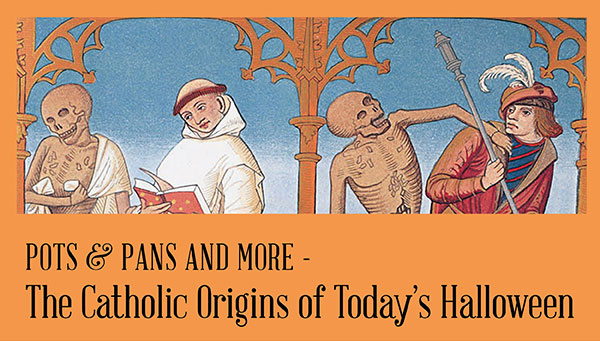
SOME OF OUR MOST POPULAR HOLIDAYS have surprising origins, and Halloween is one of them. Merrymaking, costumes, going from house to house asking for treats – where did all this come from?
Every year on November 1st the Western Church honors All Saints on the feast of that name, preceded on October 31st by All Hallows Eve ("Hallow E'en"), and followed on November 2nd by the feast of All Souls, also known as the Commemoration of All Faithful Departed or the Day of the Dead.
A Hell of a Noise
With the understanding that the "faithful departed" would by definition exclude those in hell, the peasants of medieval Ireland wondered how they should remember those souls, and even worried that if neglected, those souls may seek revenge. They solved the problem by banging pots and pans on October 31st, as a way of letting those in hell know that they weren't forgotten.
Dressing Up
Centuries later after the bubonic plague killed millions in France, those who survived prayed for the dead and meditated on their own mortality by staging elaborate All Souls' Day parades. Their danse macabre included people (frequently children) costumed as princes, popes, and paupers, following Death to the grave, side by side.
Author P.S. Conteh writes: "It was traditionally believed that the souls of the departed wandered the earth until All Saints' Day, and All Hallows' Eve provided one last chance for the dead to gain vengeance on their enemies before moving to the next world. In order to avoid being recognized by any soul that might be seeking such vengeance, people would don masks or costumes to disguise their identities". In the Middle Ages, churches displayed the relics of saints, and those parishes that were too poor to have relics let parishioners dress up as the saints instead.
Trick or Treat
In Catholic England, on October 31st people walked from house to house, promising prayers for the inhabitants' dearly departed in exchange for tasty cakes called "soul cakes" – a custom known as "souling." Years later, after England became a Protestant country, every November 5th the revelers celebrating Guy Fawkes Day visited the houses of known or suspected Catholics and demanded food or drink for their merrymaking. If the Catholics didn't want to see their homes or business vandalized, they supplied what the revelers demanded. it was a choice of...trick or treat.
The United States of Halloween
Many of these traditions died out in their country of origin. But in early 19th century America they found new life and new purpose on All Hallows Eve. Immigrants from England, France, Ireland and other parts of Europe brought their unique customs with them. Mingled in the melting pot of America, they eventually became our present holiday of Halloween.